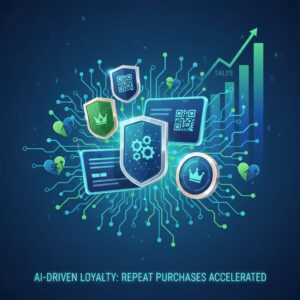
You already know that acquiring a new customer costs five times more than keeping an existing one. Yet most small business owners still pour their marketing budget into chasing new customers while their current ones slip away quietly.
I learned this lesson the hard way when I ran my first retail business. We spent thousands on Facebook ads and Google campaigns, celebrating every new customer. Then I looked at our numbers. Only 23% of customers came back for a second purchase. We were filling a leaky bucket.
That was ten years ago. Today, AI has changed everything about customer loyalty programs. The technology that once belonged exclusively to giant corporations now sits within reach of businesses making six figures or less.
AI-driven loyalty programs don’t just track points. They predict behavior, personalize rewards, and create experiences that make customers choose you over competitors. The results speak clearly. Businesses using AI-powered loyalty systems see repeat purchase rates jump by 40% to 60% within the first year.
Let me show you exactly how this works and how you can implement it in your business starting today.
Why Traditional Loyalty Programs Fail
Your punch card system isn’t working. Neither is that basic points program you copied from your competitor.
Traditional loyalty programs fail because they treat all customers the same. Buy ten coffees, get one free. Spend $500, get $50 off. These programs reward transactions, not relationships.
I watched my brother run a local bookstore with a standard points program for three years. Customers earned one point per dollar spent. The program attracted bargain hunters who disappeared the moment a competitor offered a better deal. His most valuable customers, the ones who bought regularly regardless of promotions, felt ignored.
The real problem runs deeper. Traditional programs can’t answer these questions:
Which customers are about to stop buying from you?
What specific reward will motivate Sarah differently than Michael?
When should you send an offer to maximize the chance someone acts on it?
What product should you recommend based on purchase history and browsing behavior?
AI answers all these questions automatically and acts on the answers without you lifting a finger.
How AI Transforms Customer Loyalty
AI-driven loyalty programs operate on three core principles that traditional systems can’t match.
First, they predict customer behavior before it happens. Machine learning algorithms analyze purchase patterns, browsing history, email engagement, and dozens of other signals. They identify customers at risk of leaving, usually 30 to 45 days before they would naturally drift away.
When I implemented an AI loyalty system in my consulting client’s e-commerce business, the platform flagged 340 customers as high-risk within the first week. We sent targeted offers to this group. 127 made purchases within ten days. Without AI, we would have lost most of them without knowing they were leaving.
Second, AI personalizes rewards at scale. The system learns what motivates each customer individually. Some respond to discounts. Others want early access to new products. Some prefer free shipping. A few want exclusive content or experiences.
Your AI system tests different approaches with each customer and learns what works. Over time, every interaction becomes more targeted. The coffee shop customer who always buys pastries gets offers on new bakery items. The one who only drinks black coffee gets offers on premium beans.
Third, AI optimizes timing. Sending the right offer at the wrong time wastes money. AI platforms analyze when each customer is most likely to engage. They send messages when people are ready to buy, not when you remember to send them.
One restaurant client saw email open rates jump from 18% to 47% simply by letting AI choose send times for each customer instead of blasting everyone at 10am on Tuesday.
Implementing AI Loyalty in Your Business
You don’t need a six-figure budget or a technical team to start. Here’s the practical path forward.
Start by choosing the right platform. Several AI-driven loyalty platforms now serve small businesses at reasonable prices. Look for systems that integrate with your existing point of sale or e-commerce platform. Popular options include Smile.io, Yotpo, and LoyaltyLion. Each offers AI features at different price points starting around $200 monthly.
Don’t build custom software. Use existing platforms that have already solved the hard technical problems.
Next, focus your program on behavior you want to encourage. Most businesses only reward purchases. AI lets you reward actions that lead to purchases. You can award points for:
Writing product reviews
Referring friends
Following you on social media
Engaging with your content
Completing their customer profile
Providing feedback
I helped a fitness studio implement an AI loyalty program that rewarded class attendance, booking in advance, bringing friends, and posting workout photos. Revenue from existing members increased 34% in six months because the program encouraged the behaviors that led to long-term retention.
Set up your customer data correctly from day one. AI systems need clean data to work effectively. Make sure you’re capturing:
Email addresses
Purchase history
Product preferences
Engagement metrics
Demographic information when available
The more data your AI system has, the better it performs. But start with the basics and expand over time.
Launch with a small test group first. Pick 200 to 300 existing customers and run your AI loyalty program with them for 60 days. Measure repeat purchase rate, average order value, and customer lifetime value against a control group. This approach reduces risk and gives you proof of concept before rolling out to your entire customer base.
Measuring Real Results
Track the metrics that actually matter. Vanity metrics like program enrollment rates don’t pay your bills.
Focus on these four numbers:
Repeat purchase rate: The percentage of customers who buy from you more than once within 90 days.
Customer lifetime value: The total revenue you generate from a customer over the entire relationship.
Purchase frequency: How often customers buy from you compared to before joining the program.
Redemption rate: The percentage of earned rewards that customers actually use.
A good AI loyalty program should increase your repeat purchase rate by at least 25% within six months. If you’re not seeing movement in this number, something needs adjustment.
One manufacturing client I worked with tracked these metrics monthly. After implementing AI-driven loyalty, their repeat purchase rate climbed from 31% to 52% over eight months. More importantly, customer lifetime value increased from $870 to $1,340. The program paid for itself in the first quarter.
Watch your redemption rate carefully. Low redemption means your rewards don’t match what customers actually want. AI systems should optimize this automatically, but you need to monitor and adjust.
You can implement AI-driven loyalty programs in your business this quarter. The technology works. The platforms exist. The only question is whether you’ll act before your competitors do.
Your existing customers represent your most valuable asset. AI gives you the tools to keep them coming back without working harder or spending more on acquisition.
The businesses winning in the next decade won’t be those who attract the most new customers. They’ll be the ones who turn first-time buyers into loyal advocates through intelligent, personalized experiences that feel human even though machines power them.
Please check our Business Tips https://thoughts.business/category/business-tips/
Please check our partner site – Why Invest? https://whyinvest.info/





